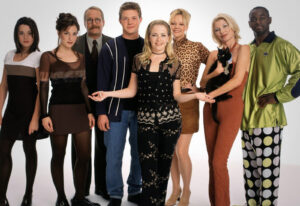Nell Scovell Talks About The Groundbreaking Sabrina, The Teenage Witch
Posted on October 4, 2021 at 12:13 pm

Posted on October 4, 2021 at 12:13 pm

Posted on July 18, 2016 at 7:50 am
My friend Nell Scovell has a terrific article in the New York Times about Hollywood’s poor record on women directors. While just about any male director with an indie at a festival is handed a superhero movie with a $100 million budget and, even more telling, male directors whose films lose money still get a chance to make another, women directors, even those with a record of excellent work, do not.
In television, most studio executives and showrunners claim they are looking for female directors, but I suspect it’s the same way that I sometimes look for the sunglasses on my head: They’re right there, but I can’t see them.
People insist it’s a pipeline problem when it’s really a broken doorbell problem. Competent and talented women are right there on the doorstep, hitting the buzzer, but no one is answering the door. Last year, even with constant calls for more gender diversity, 86 percent of the first-time TV directors were still white males.
Past efforts, including allowing aspiring women directors to “shadow” established directors, have not been successful at increasing the number of women in director jobs. Scovell has some practical suggestions for change that go beyond the usual “let’s try harder.”
All networks and showrunners should look at the genders of their directors for the coming season. They don’t have to balance the roster 50/50 — although that would be awesome — they just have to make sure they beat last year’s 17 percent benchmark, which includes a scant 3 percent minority women. Make every fifth director a female. Just do better and the numbers will rise each year, creating a new benchmark to beat, until we hit equality.
Next, studios should flip the shadow programs. From now on, let the newcomers do the directing and pay the old hands to shadow them. The green directors get to rack up real credits while the show has a safety net.
Posted on February 15, 2015 at 4:08 pm
My friend Nell Scovell has an excellent piece in the New York Times about why the “host of possibilities” that Jon Stewart’s departure from “The Daily Show” opens up should focus on a woman as his replacement.
t will be the sixth time in just over a year that a prominent late-night desk will be up for grabs. All this turnover would seem like a great opportunity to throw a female host into the mix. But it hasn’t happened yet. So next time, right? There’s always next time. Except next time probably won’t be for a long time. Most late-night hosts stay put for decades. It’s the closest thing to a Civil Service job in TV.
Scovell’s list is long and telling. The departures of Matt Smith (Dr. Who), Craig Ferguson, David Letterman, Stephen Colbert, and Jay Leno all led to calls for women to be considered and replacements who are male. No question that all of those replacements are enormously talented. But are they the only talented options? Or the most talented?
The one solace: Whoever gets Mr. Stewart’s job will do better at hiring women than Jay Leno and Mr. Letterman, but that’s only because you couldn’t do worse. Mr. Leno went off the air with zero female writers; Mr. Letterman is set to bow with just one. (I like the image that together they average half a woman.)
At this point, I’d cheer a host being joined by a female sidekick.
This week’s release “Hot Tub Time Machine 2” has the heroes go into the future. There are some pretty wild predictions about what lies ahead, but for me, the one that I wish was less of a long shot is the future host of “The Daily Show,” my favorite of its correspondents, Jessica Williams.
Posted on October 28, 2014 at 3:37 pm
The wonderful Nell Scovell, who helped Facebook’s Sheryl Sandberg write Lean In and is now working on a screenplay based on the book, has an excellent essay in Time about the talented women who appeared on “Saturday Night Live” but never transitioned to the kind of high-profile careers that some of their male peers did. Her list includes Nora Dunn, Ana Gasteyer, Julia Sweeney, Molly Shannon, and Maya Rudolph. “Very few women from SNL have gone on to “a big movie career.” Of course, Fey did, along with Amy Poehler and Kristen Wiig. And in TV, Julia Louis-Dreyfus is in a class all her own, with 18 Emmy nominations and five wins for three different roles. Still, their success stories are the exceptions to Hooks’s rule.” She documents the difference in the numbers of male and female performers over the years. I think one additional reason also has to do with numbers — the way Hollywood treats men and women differently as they get older.
Critic Ann Hornaday made this point very tellingly in the Washington Post:
“That’s what I love about these high school girls, man. I get older, they stay the same age.”
That line from Richard Linklater’s classic 1993 comedy “Dazed and Confused” came back with an ironic vengeance this week, and die-hard fans of the film will know why: It’s spoken by a 20-something stoner named David Wooderson after a cute-looking teenager walks by. Wooderson is played by Matthew McConaughey, and the girl is a young actress named Renee Zellweger.